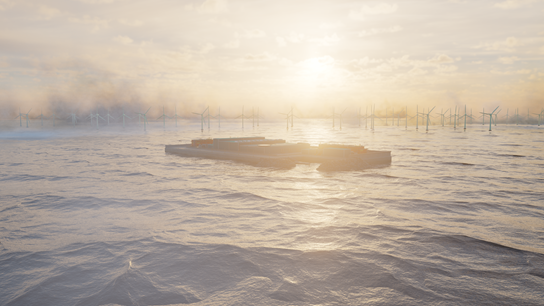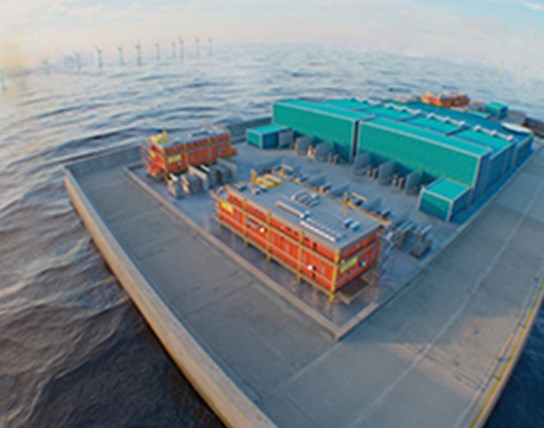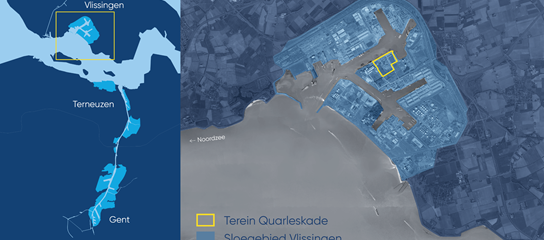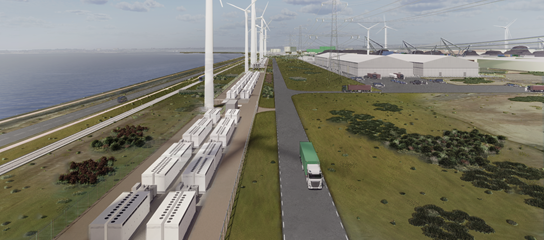Construction of parts for worlds first energy island: North Sea Port supports energy transition in Belgium
Princess Elisabeth Island will be an energy hub 45 km off the Belgian coast connecting new wind farms and additional interconnectors (to the UK and Denmark) to Belgium's onshore power grid. Obtaining the permit is a key condition for building the world's first artificial energy island in the North Sea. North Sea Minister Vincent Van Quickenborne has approved the relevant environmental permit. In the meantime, Elia is putting the final touches on a nature-inclusive design for the island that will be submitted later this year. Construction will take around two years (March 2024 to August 2026).
“North Sea Port is keen to contribute to Europe's energy transition, together with Elia, DEME and Jan De Nul. By expanding international high-voltage connections and incorporating ever-increasing amounts of renewable power, Elia is promoting both the integration of the European energy market and the decarbonisation of society. This project has further strengthened our long-term collaboration.”
Daan Schalck, CEO North Sea Port
Preparing the worksite in Vlissingen
A consortium comprising Belgian marine construction companies DEME and Jan De Nul has already started preparing the site in Vlissingen where it will build the caissons. That are the concrete foundations each of which is approximately 60 m long, 30 m wide and 30 m high. In late June 2023, an environmental permit was granted for the construction on the premises of Verbrugge Zeeland Terminals at Bijleveldhaven On this location in North Sea Port the 23 concrete caissons () will be built, launched, stored and, in the summers of 2024 and 2025, towed to the offshore location and immersed. Afterwards the island will be sand fill reclaimed and prepared for the construction of the high-voltage electrical infrastructure.
Nature-inclusive design promotes marine biodiversity
For months now Elia has been working with experts from public and private institutions, universities and non-governmental organisations to optimally integrate the energy island's infrastructure into the marine environment. In opting for a nature-inclusive design, the island's potential for marine biodiversity has been fully exploited. Based on this research, specific measures will be formulated that will then be submitted later this year and ultimately integrated into the island's design.
“We plan to continue developing the North Sea as Belgium's leading energy centre and Princess Elisabeth Island will be a crucial part of this process. With this environmental permit, we are now taking a major step forward in developing the Princess Elisabeth Zone, our second offshore wind zone. The first wind turbines will commission in 2028, delivering additional offshore green energy for our families and companies. Since Belgium is also the first country in the world to install wind turbines in protected marine areas, we are delighted that Elia is fully committed to nature-inclusive design.”
Vincent Van Quickenborne, Deputy Prime Minister and Minister for Justice and the North Sea
Princess Elisabeth Island
Princess Elisabeth Island will be the first artificial energy island in the world to combine both direct current (HVDC) and alternating current (HVAC). The high-voltage infrastructure on the island will bundle together the export cables from the wind farms in the new Princess Elisabeth Zone while also serving as a hub for future interconnectors with the United Kingdom (Nautilus) and Denmark (TritonLink). Not only will they handle power exchanges between countries, but they will also be connected to new offshore wind farms in the North Sea that will eventually supply Belgium with large quantities of renewable energy.
“Belgium is a leader in offshore wind. It is accelerating the energy transition via a fourfold increase in offshore wind capacity in the Belgian North Sea, the construction of an energy island and new interconnectors with countries which surround the North Sea. The energy island will become an offshore wind energy hub that will provide green, affordable energy for our families and companies. It is important that we take marine life into account, both above and below water. It is good that Elia is continuing to focus on Nature Inclusive Design.”
Tinne Van der Straeten, Federal Minister for Energy
Located some 45 km off the coast and covering 6 hectares (12 football fields), in the middle of the Princess Elisabeth Zone, Princess Elisabeth Island will be built on concrete caissons filled with sand. The island will house almost exclusively transmission infrastructure used to connect new wind farms (up to 3.5 GW) as well as future interconnectors. There will also be a small harbour for maintenance crews and a helideck. Some 300 km of alternating current cables (HVAC) and 60 km of direct current cables (HVDC) will be installed around the island to connect all future offshore facilities to the Belgian high-voltage grid.
Picture: Elia.





